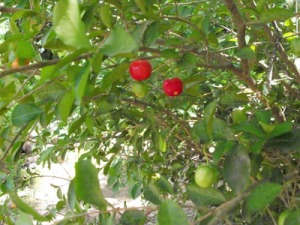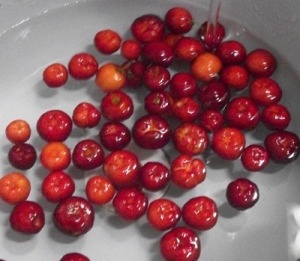Acerola
“If life is a bowl of cherries, then what am I doing in the pits?”
-Erma Bombeck
Acerola is a plant native to Southern and Central America – specifically the Yucatan. It produces small edible fruits which look a lot like cherries, leading to the common alternate names of Barbados Cherry, Puerto Rican Cherry, and West Indies Cherry (…guess where else they grow? :p). The fruits are widely consumed in South America in fresh and preserved forms. In the United States, acerola is used as an decorative tree in the southern Florida and the Lower Rio Grande Valley of Texas. It can be found in Mexico, Central America, the Caribbean, and South America as far south as Peru and Bahia in Brazil. It is cultivated in the tropics and subtropics throughout the world.
We’ve been learning a lot about the indigenous fruits here in Sobral. Alex’s dad actually has several fruit trees in his yard (two of which are acerola), and we spent the better part of a recent afternoon swatting at fruit flies and craning our necks picking an enormous amount of fresh acerola. They’re so abundant here that most of the people who have trees on their yard see them as a nuisance – they produce so much fruit because of the tropical climate that it’s way too much to use, so a lot of it falls on the ground and either rots or gets eaten by bugs and animals. We had the neighbors help us choose the ripest ones – the reddest, most even fruits with the fewest bug bites possible.
We didn’t want to cook with the acerola – we wanted to process it as minimally as possible so we could get the full taste of the fruit. Eating them raw was…not that great, actually. They’re pretty sour and a little tannic; cross-breeders in the United States have actually recently developed sweeter varieties, including Florida sweet and Manoa sweet. We decided to blend them into juice along with a few ripe mangoes we picked – it was delicious! In most of the juice shops we saw in São Paulo, acerola is almost always blended with orange juice and drunk for breakfast or as an afternoon pick-me-up.
Health Benefits
Acerola is known for its extremely high vitamin C content. Analysis has shown that the acerola is the richest source of vitamin C of any fruit. In the 1940’s, large commercial plantings were established in the US for processing, particularly for making Vitamin C tablets. However, some time later, synthetically produced vitamin C became more economical to produce, but some companies still prefer to use acerola rather than artificial ingredients. There is 1677.6 mg of vitamin C in 100 g of fruit, making it one of the highest natural sources of ascorbic acid (only exceeded by rosehip). Acerola has 32 times the vitamin C of an orange – over 3000% more. This table has a side-by-side nutritional comparison of acerola, orange, and apple juices.
Vitamin C is an antioxidant that helps promote collagen, which gives the skin its elasticity and keeps it from breaking apart.
- Acerola is used as an ingredient in skin care products to stop or reverse the aging process.
- Early uses for the fruits were to treat dysentery and to enhance the function of the liver.
- Because acerola is high in vitamin C, it is used in a supplement to boost immunity. These are generally in tablet form by themselves or in a multi-vitamin. But be careful… overdosing on vitamin C supplements can lead to diarrhea.
- The juice and the fruit are both used to reduce inflammation, flush water out of the system, heal wounds, support the function of the heart and to reduce the symptoms of rheumatism, diabetes, anemia and tuberculosis.
- Acerola is also used to replace vitamin C lost when taking certain Tetracycline-based antibiotics.
- In herbal and homeopathic medicine, acerola is also used in the management of both Parkinson’s disease and Herpes.
In the 1950s, a manufacturer of baby food decided that apple juice was milder for infants than orange juice. The company claimed that a drop of acerola juice in an 8 oz. can of apple juice provided the amount of vitamin C of an equal amount of orange juice. A detailed nutrition facts analysis supported the claim.
Acerola can be made into jelly, jam, preserves, puree, pie, sherbet and wine, and the pulp is delicious when blended with toasted mate. Acerola flavor is also used in Tic Tacs. The most interesting recipe I saw was an acerola and mint jelly using hot-pressed acerola juice and peppermint extract; there was also an acerola-habanero jam that sounded delicious, too – but then again, I’m a sucker for any type of pepper jelly or jam.

Bolthouse Farms' C-Boost
I had actually heard about acerola while I was living in New York – for the better part of 2008, I worked as a field representative for Bolthouse Farms, a juice company based out of California that specializes in all-natural, super-healthy juices and smoothies. In my opinion, one of their best products is called “C-Boost” – it’s made with acerola, camu-camu, and several other fruits, and it’s marketed for immune system support. If you’d like to try acerola, I recommend their products. It’ll never be as good as if you picked it and juiced it yourself, but it’s good for a general idea of the taste (plus it’s good for you!) 🙂
In his book, Alex Atala has a recipe for pigeon and foie gras capeletti (the bellybutton-shaped stuffed pasta) in a port wine infused broth with cured acerola as a garnish. First, he fries the fruit to blister the skins. While they’re still warm, they’re peeled, halved, and pitted. He then “cures” them in a mixture of salt and sugar – for every 100g. of acerola, use 10g. salt and 10g. sugar. They’re left to marinate in the cure for at least an hour, and then they’re put into the hot broth. It’s not on the current menu, but it sounds delicious – it’d probably work with regular fresh sour cherries, too.
Have you tried acerola in any form? How have you seen it marketed in the US?




I’ve seen this in some juice blends here in the states. I’m not sure if I’ve tried it yet, but might pick some up next time I see it. I wonder if I could stop taking my iron if I started drinking this juice?? Not that I take it like I should anyway…haha
отлично сделано, интеретсно читать 98)
awesome blog, do you have twitter or facebook? i will bookmark this page thanks. jasmin holzbauer